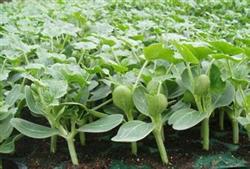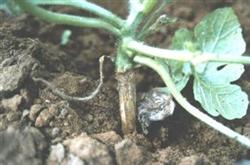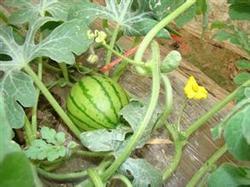Four key steps in raising Watermelon seedlings with Hot Kang

The hot Kang seedling of watermelon has the characteristics of fast heating, uniform temperature, low cost, simple operation and so on. Strong watermelon seedlings can be cultivated in January and February when the temperature is very low, and the effect is similar to that of an electric hotbed. First, build a seedbed. First of all, dig a bed pool that is 4.5 meters long from east to west, 1.6 meters wide from north to south and 0.2 meters deep. At the same time, dig a fire pit at one end of the bed pool, which is 1.3 meters long from north to south, 1 meter wide from east to west and 1.5 meters deep. Then, dig a 0.4-meter-wide trench along the bottom of the bed pool, one end of the burning pit is 0.4 meters deep, away from one end of the burning Kang 0.2 meters deep, the north-south ditch bottom smoothly into a natural slope. Cut the middle soil into a slope where one end of the burning pit is 5 cm deeper than the bottom of the original pool, and the other end is level with the bottom of the trench. Digging a small ditch with a depth of 16 cm and a width of 16 cm in the middle of the ditch at one end of the fire pit is the fire heating channel, and dig to the other end along the bottom of the ditch on the south and north sides, turn to the center respectively, and turn back to the end of the fire mouth along the central slope. On the wall near the nursery bed in the fire pit, facing the center of the bed pool, dig an arch hole with a semicircle at the top, 0.6 meters high, 0.45 meters wide and 0.3 meters deep. In the inner and upper part of the hole, dig a 0.13 meter diameter fire path toward the top fire path in the bed pool, make it communicate with the fire path in the bed pool, and put the furnace in the middle of the hole. Cover the fire path in the bed pool with tiles or other objects and apply it strictly with mud to prevent water leakage, fill the soil firmly and restore the height of the bottom of the original bed. The middle two fire channels should extend to the outside of the bed at one end of the fire pit and communicate with the smoke window on the bed wall. Finally, a fence is built around the bed pool. The north wall is 40 centimeters high, the south wall is 10 centimeters high, and the east and west ends are sloping walls. Second, prepare for the broadcast. After the nursery bed is built, the nursery bed is discharged with a nutrition bowl or filled with nutritious soil to water "block" to raise seedlings. The nutritious soil is made of field soil that has not been planted with melon crops, plus mule and horse manure fermented by 1hamp3, or half of the screened field soil and half of the manure. Mix 0.5 kg urea (or diammonium phosphate) into each cubic meter of bed soil and fill it into the bed with a thickness of 10 cm. Pour the seedling bed with warm water 3 days before sowing. When the water seeps into the bed and the soil is not too sticky, cut it into a 10cm "dirt block" and fill the gap with fine sand, then cover the bed surface with a film to make a fire and heat it. Third, sow seeds at the right time. The sowing time should be controlled according to the cultivation mode and the required seedling age. Generally, extra-precocious watermelons should be sown in mid-February. The seeds were soaked and germinated before sowing. When the ground temperature of the nursery bed rises to more than 16 ℃, the treated seeds can be sown in a "tutuo" or nutrition bowl around noon on a sunny day, with a thickness of 1 cm. Cover the film after sowing, seal it strictly, and cover it with grass to keep warm and keep cold at night. Fourth, heating management. After sowing, the bed temperature was kept at about 30 ℃. When most of the seedlings emerged, the bed temperature was kept at 20-25 ℃ during the day and 15-20 ℃ at night. After heartbreak, it can maintain 22-28 ℃ in daytime and 15-20 ℃ at night. After emergence, the mulch should be uncovered early and late to increase the light in the bed. if the bed soil is found to be too dry after the true leaves appear, spray 30 ℃ warm water at noon on a sunny day, and cover the film immediately after watering. If fertilizer deficiency is found, 2% urea water can be sprayed on the leaves.
- Prev

Comprehensive Control of Watermelon Seedling Diseases
1. Symptoms of major diseases. 1. Cataplexy. In the initial stage, there is a phenomenon in the root and stem of the seedling (the joint of the root and stem). The disease spot is the same as boiling water, and then the disease part becomes yellowish brown and dry shrinks, the cotyledons have not yet withered, and the seedlings fall to the ground. Stunting disease often occurs in the seedling cotyledon stage unearthed to 2 true.
- Next

Three measures for watermelon post-flowering management
It is difficult to set fruit if watermelon is in low temperature and rainy season with artificial pollination. On the one hand, the low temperature and rainy weather is not conducive to the activities of pollinators such as bees; on the other hand, the rain is too much, it is easy to wash away the pollen on the female flower stigma or make the pollen burst and lose the germination ability, and it is difficult to complete the fertilization.
Related
- Moge, come on! The staff of the peasant association in the producing area of cantaloupe were frightened when the crowd gathered.
- Causes and Solutions of low Fruit setting rate of Apple
- Symptoms and control measures of passion fruit virus disease
- Fruit growing lesson: how do apple orchards keep high yields?
- Can you build orchards in the mountains? What are the pros and cons?
- How to manage the coloring period of Crisson grape?
- This paper introduces the processing technology of two kinds of fig products.
- How much is a month for retired teachers in rural areas by 2020?
- How can strawberry planting increase sugar content? We should pay attention to management in many aspects.
- What are the cultivation techniques on how to improve the yield of golden fruit?

